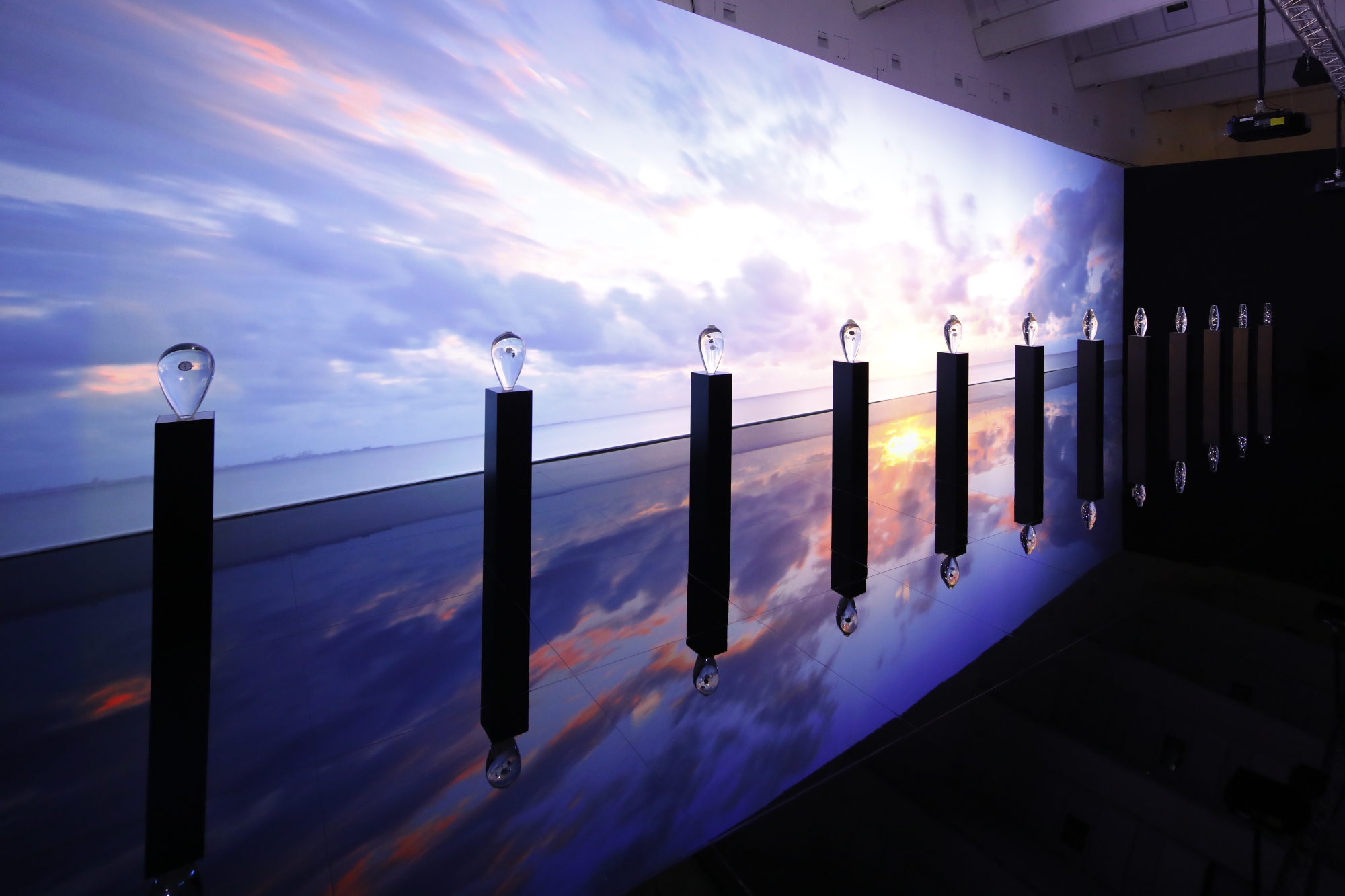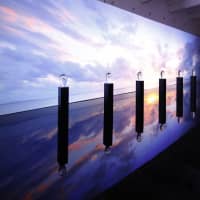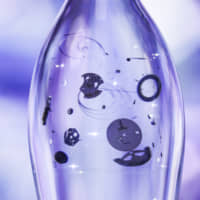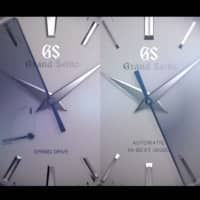Dramatizing the flow of time in the form of an art installation, Seiko Watch Corp. is taking part in the Designart Tokyo 2018 event through this weekend, featuring its flagship watch brand Grand Seiko.
The installation was first exhibited in Milan in April, which was Seiko's first participation in Milan Design Week, an annual international design celebration in Italy.
As Seiko Chairman and CEO Shinji Hattori said in his message for Milan Design Week, Seiko wants to communicate the worldview they have incorporated into their watches in the form of art that can be experienced by the five senses and provoke an emotional response.

"Although we have been good at emphasizing the functional appeal of our products such as precision, superb accuracy and specifications, I wanted to further convey to the world the emotions and aesthetics we put into our work as a designer," said Kiyomi Tanemura, general manager of the design center department at Seiko, who was responsible for the exhibition.
For instance, a designer hailing from Japan's Hokuriku region created the pure white dial of the Grand Seiko watch, which is dubbed snowflake.
"He had an image of a silent snowfield in his mind," Tanemura said. "He thought about a snowfield in his hometown, where his grandfather took him when he was a small child. Time ran slowly there," she said.
Whether they say so or not, there are always such innermost stories or thoughts behind their designs, and all these are condensed within the products. An art installation is an effective way to demonstrate such emotions and thoughts on a large scale.
As the theme of the company's first presentation in Milan, Seiko focused on the Grand Seiko brand that made its debut in 1960 as the embodiment of the ideal watch. Among the three types of Grand Seiko watches, the exhibition features the one with Spring Drive movement, Seiko's unique and innovative mechanism that combines the power of a mainspring and the accuracy of a quartz crystal. The smooth gliding motion of the second hand that the Spring Drive movement produces is a reflection of the silent and continuous natural flow of time that is at the heart of the Japanese sense of beauty.
Titled "The Flow of Time" and produced by Toshiki Kiriyama, the art installation is a collaboration between design studio Takt Project, led by Satoshi Yoshiizumi, and computer graphics director Shingo Abe.
"Thanks to the excellent creators with an engineering background, who immediately understood the cutting-edge technologies, as well as our emotional approach in presenting them, we could work together as a good team," Tanemura recalled.
Designed by Takt Project, one component of the installation, "Approach to Time.," involves 12 acrylic objects in different shapes placed on plinths. Inside the transparent objects — each of which are differently shaped — are the components of the Spring Drive watch movement. More than 200 parts that make up the mechanism are scattered about in the first object. They then merge together progressively until they are finally assembled into a moving mechanism inside the 12th object, which is shaped much like an upside-down pot. The display allows visitors to see how the watch comes together. Due to the high refractive index of acrylic, the components inside are magnified according to the shapes of the 12 objects.
"Looking into the objects, visitors can see all these tiny and thin components that are beautifully produced and polished by the refined human sensitivities of each experienced craftsman," Tanemura explained. "And such smooth, shiny finishes are not for the sake of beauty, but to reduce friction. It's a result of our single-minded pursuit of the essence of the watch."
Also, small lights in the transparent objects imply the existence of tiny amounts of electricity generated by the parts themselves, representing the idea behind the Spring Drive movement.
Projected on the screen behind the objects was a movie created by Abe. The movie includes footage of scenes such as sunrises, blossoms falling and ripples of water — all of which were meant to represent the Japanese people's adoration for natural beauty and flowing time. Also featured were modern landscapes of Japan.
"The visual work captures the flow of time in the universe and on Earth. In other words, it represents the 'macrocosmos' surrounding us, with the Spring Drive movement inside the object being the microcosmos," Tanemura said. "We intend that the macrocosmic visuals reflect on the microcosmic object and the two become one."
Another component of the installation is an image product created by Abe called "Kizamu/Nagareru," or "Ticking time/flowing time." It presents the difference between the mechanical watch movement that ticks and the Spring Drive movement that flows. The contrast is poetically expressed through the images of the sun's trail drawing an arch in the sky, raindrops and leaves falling to the ground and stars orbiting in the night sky.
Since ancient times, Japanese people have appreciated the beauty of nature and felt themselves as part of it, rather than regarding nature as something that human beings should face, overcome and control. Likewise, Japanese people feel themselves inside the flow of time, rather than regarding time as something external that clocks and watches tick down.
The installation won favorable recognition among critics, as well as the general public, at Milan Design Week.
"Visitors lounged on the bench and spent time to appreciate the installation, perhaps feeling the flow of time," Tanemura said. "I'm pretty sure that they got a sense of what we wanted to convey. At least, people felt comfortable staying there. Our exhibit is also Instagram-worthy."
For the current exhibition, part of the movie footage has been replaced with a Tokyo-specific version, containing scenes such as nightscapes of Ginza. Due to the space constraints of the venue, both the screen and the line of 12 objects form into an arch.
"The venue is narrower than that of Milan, but visitors will enjoy the condensed space as if they are in a different dimension, perhaps inside the Spring Drive," Tanemura said.
Through the success of the first exhibition at Milan Design Week, the company aims to further promote such an emotional approach to branding. The installation is scheduled to travel to the U.S. in December.
"I believe that an emotional approach is only possible when we really manufacture products with emotions," Tanemura said. "In this sense, we have confidence in Grand Seiko. It's a product of our pride."
The Grand Seiko watch and the Spring Drive movement inside share the spirit of pursuing the essence of timepiece and Japanese sense of beauty.
The exhibition provides visitors with an opportunity to experience a space of beauty where time flows serenely. Surrounded by nature, as seen in the movie, and at the end of the 12-step creation of a timepiece, visitors will rediscover the essence of how we Japanese feel time in mind, as the smooth gliding motion of the second hand inside the final object indicates.
"The Flow of Time" is an official program of the Designart Tokyo 2018 and runs through Oct. 27 at Polygon Aoyama, a two-minute walk from exit A3 Tokyo Metro Omotesando Station. Open daily from 10:30 a.m. to 7:30 p.m. Admission is free.






















With your current subscription plan you can comment on stories. However, before writing your first comment, please create a display name in the Profile section of your subscriber account page.